Understanding Benzodiazepine Detoxification
Benzodiazepines, often prescribed for anxiety and insomnia, can lead to dependence, making discontinuation a challenging prospect. This article delves into the complexities of benzodiazepine detoxification and addresses the critical question: can it be done safely at home? While at-home detox might seem convenient, it’s important to understand the associated risks and the potential need for professional intervention to ensure a safe and successful recovery.
The Detoxification Process
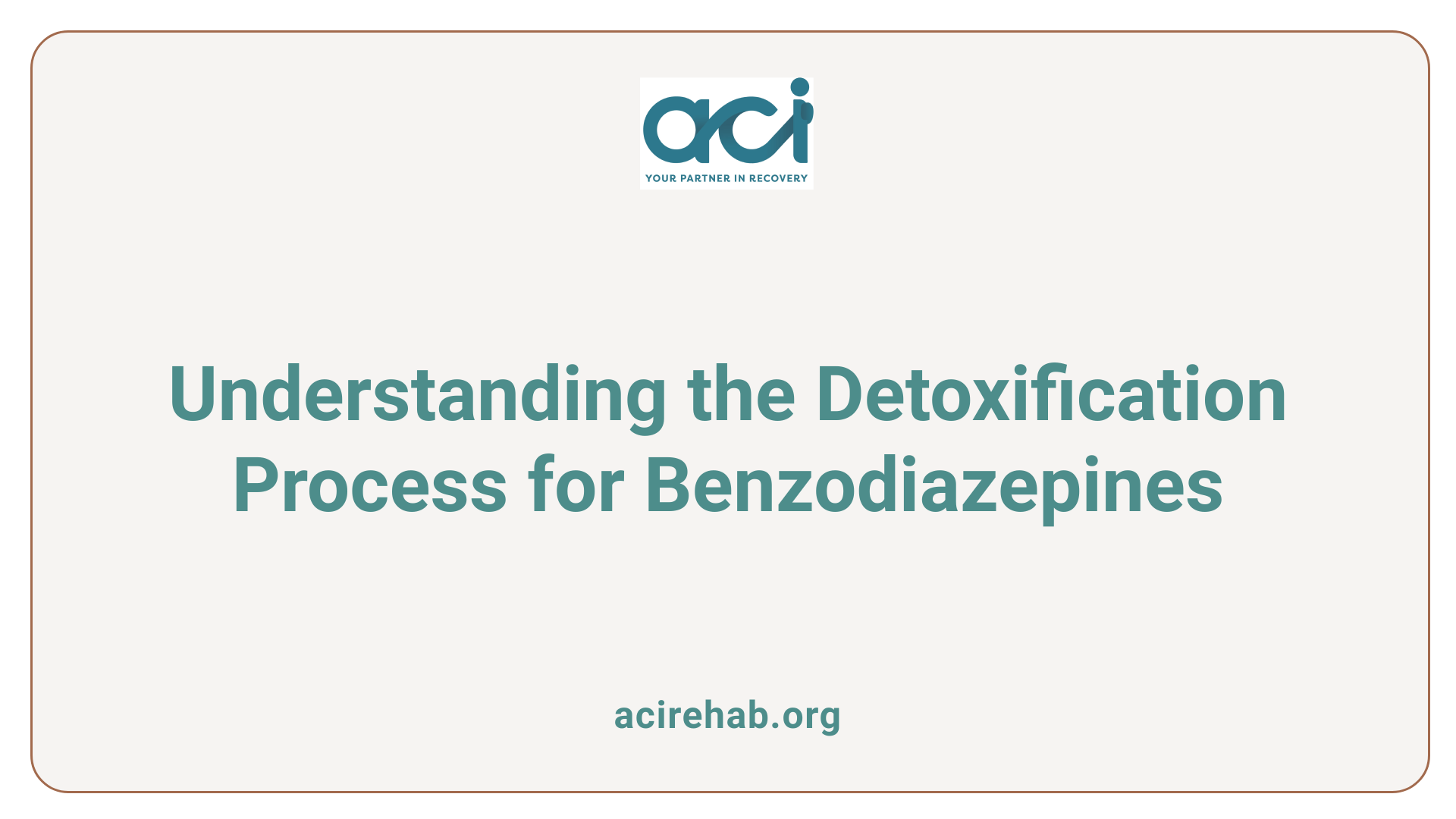
What is the detoxification process for benzodiazepines?
The detoxification process for benzodiazepines is critical for ensuring safety and comfort during withdrawal. It typically involves a medically supervised tapering strategy designed to safely reduce drug dependence. Abruptly stopping benzodiazepines can trigger severe withdrawal symptoms such as anxiety, tremors, and seizures, which may pose serious health risks.
To begin the tapering process, a recommended approach is to start with a 25-30% reduction of the current dosage for individuals who have been using high doses chronically. After this initial adjustment, a more gradual tapering of 5-10% weekly can be implemented. In some cases, substitution tapering may be beneficial. This method involves switching the patient to a long-acting benzodiazepine, allowing for a smoother withdrawal experience.
Behavioral therapies also play a vital role in the detoxification and recovery from benzodiazepine addiction. These therapies help support individuals emotionally and psychologically, providing coping strategies tailored to their specific needs. Engaging in behavioral therapy can significantly improve the chances of a successful detox and recovery, addressing underlying issues and reducing the risk of relapse.
| Tapering Method | Description | Benefits |
|---|---|---|
| Initial Dose Reduction | Reduce dosage by 25-30% for high dosage users | Minimizes acute withdrawal symptoms |
| Gradual Tapering | Decrease dosage by 5-10% weekly | Allows adjustment and comfort |
| Substitution Tapering | Switch to long-acting benzodiazepine | Eases withdrawal discomfort |
| Incorporation of Therapies | Include behavioral therapies to support recovery | Enhances coping and reduces relapse |
Professional supervision during this process not only minimizes withdrawal discomfort but also prevents the potential for dangerous complications, making it an essential component of any benzodiazepine detox plan.
Risks of Abrupt Cessation
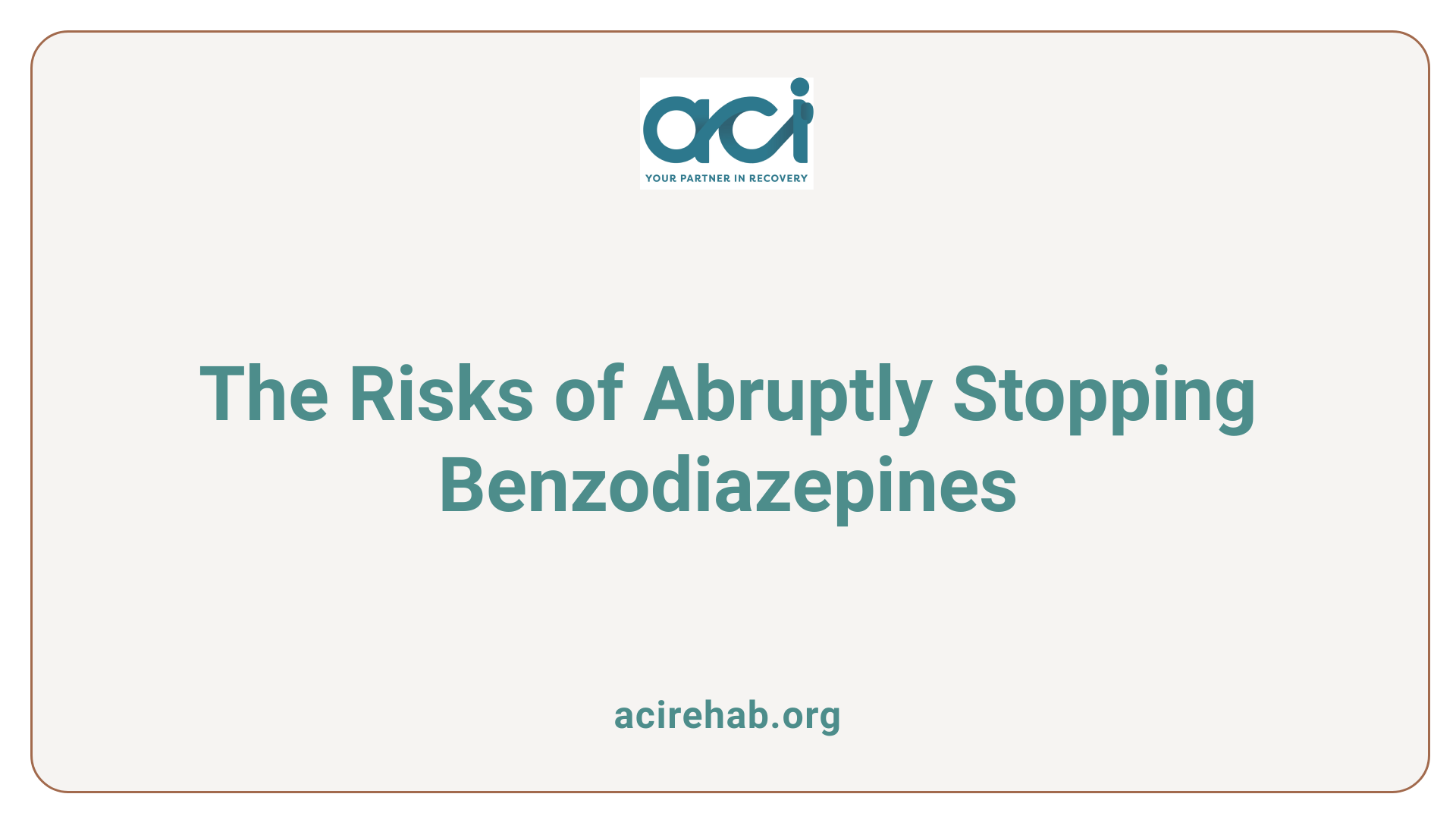
What are the risks of abruptly stopping benzodiazepines?
Abruptly stopping benzodiazepines can trigger a withdrawal syndrome that poses significant health risks. Symptoms may emerge quickly within 24 hours and can vary widely in intensity. Common experiences during this withdrawal phase include:
- Sleep disturbances
- Increased anxiety and tension
- Irritability and mood swings
- Hand tremors and sweating
- Difficulty concentrating
Rebound effects, such as heightened anxiety and insomnia, typically occur within 1 to 4 days after discontinuation. As withdrawal progresses, some individuals might face a full-blown syndrome lasting between 10 to 14 days.
Symptoms and duration
For those with prolonged or high-dose use, withdrawal complications can include severe outcomes such as:
- Seizures
- Hallucinations
- Severe anxiety
- Psychotic episodes
While many symptoms subside relatively quickly, individuals may experience lingering effects for months, indicating potential changes in their central nervous system.
Dangers of untreated withdrawal
The dangers of untreated withdrawal from benzodiazepines cannot be overstated. Symptoms like seizures and psychotic reactions can become life-threatening if left unmonitored. Moreover, attempting to detox at home can increase the risk of relapse and severe complications, underscoring the necessity of a medically supervised tapering strategy to safely navigate withdrawal.
Understanding Withdrawal Symptoms and Timelines
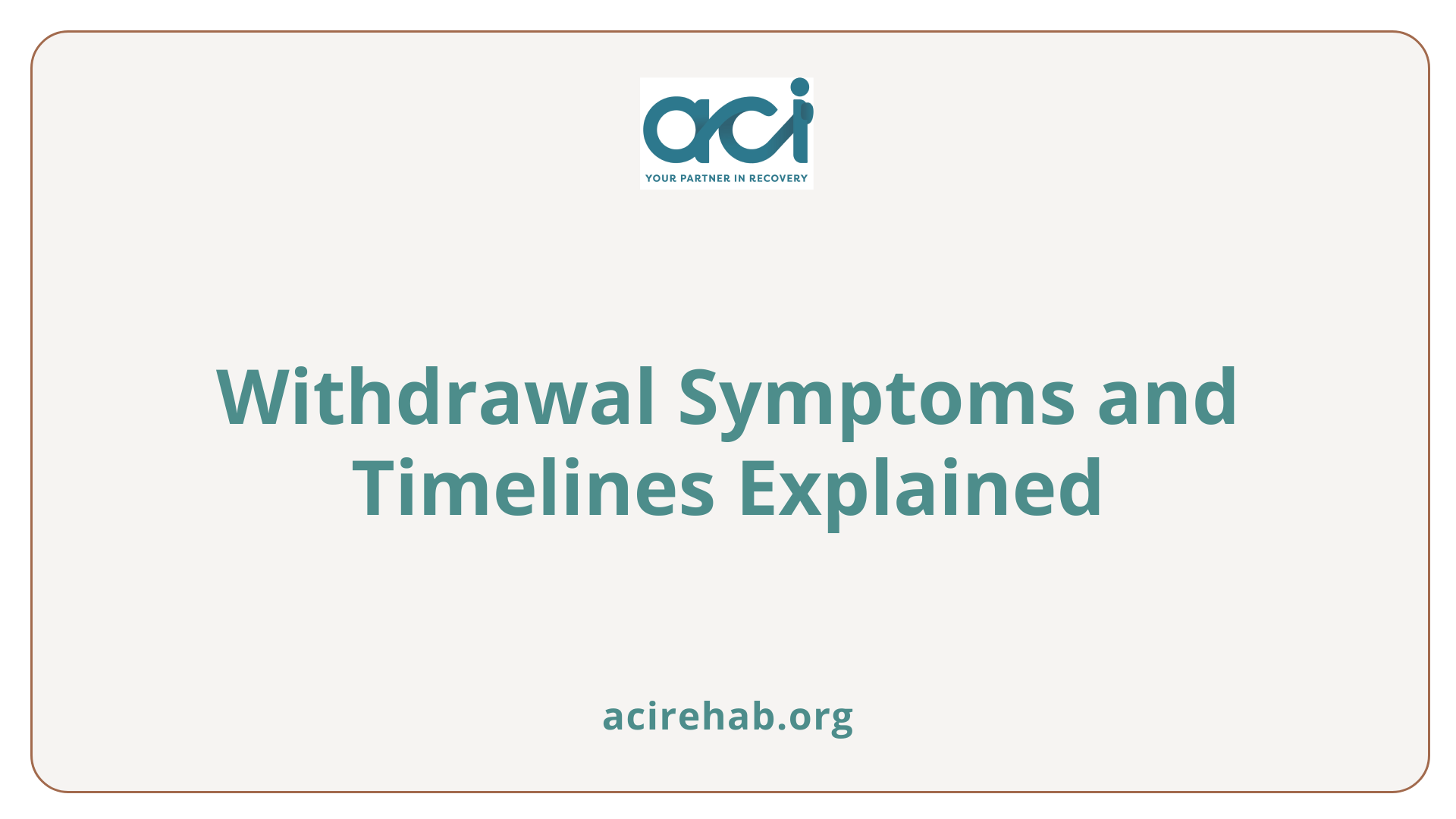
What are the withdrawal symptoms and timelines for benzodiazepines?
Withdrawal from benzodiazepines typically begins within 24 hours of discontinuation and can last from a few days to several months, influenced by factors like the length of use and the specific benzodiazepine taken.
Different phases of withdrawal
The withdrawal experience can be divided into three phases:
- Early Withdrawal: Symptoms can start within hours to a couple of days. Individuals may experience mild anxiety and sleep disturbances.
- Acute Withdrawal: This phase usually begins a few days after the last dose and can last for 2 weeks to several months. Symptoms become more intense and may include panic attacks, tremors, and, in severe cases, seizures.
- Protracted Withdrawal Syndrome: Affecting about 10-25% of long-term users, this phase can persist for months or even years, characterized by prolonged anxiety, insomnia, and cognitive difficulties that may appear unpredictably.
Short-acting vs long-acting benzodiazepines
- Short-acting Benzodiazepines (e.g., Xanax): Symptoms can emerge within 6 to 12 hours after discontinuation and may peak around day 2.
- Long-acting Benzodiazepines (e.g., Valium): Symptoms might not manifest until 24 to 48 hours after the last dose, with a potentially prolonged withdrawal experience.
Severity of symptoms
The severity of withdrawal symptoms can vary significantly among individuals. While some might experience mild discomfort, others face life-threatening conditions such as seizures and delirium, especially when stopping abruptly. High-risk groups, including the elderly and pregnant women, may be particularly vulnerable to severe effects.
Effective management and support during this challenging process are crucial for anyone undergoing benzodiazepine withdrawal.
Medications Utilized in Detox
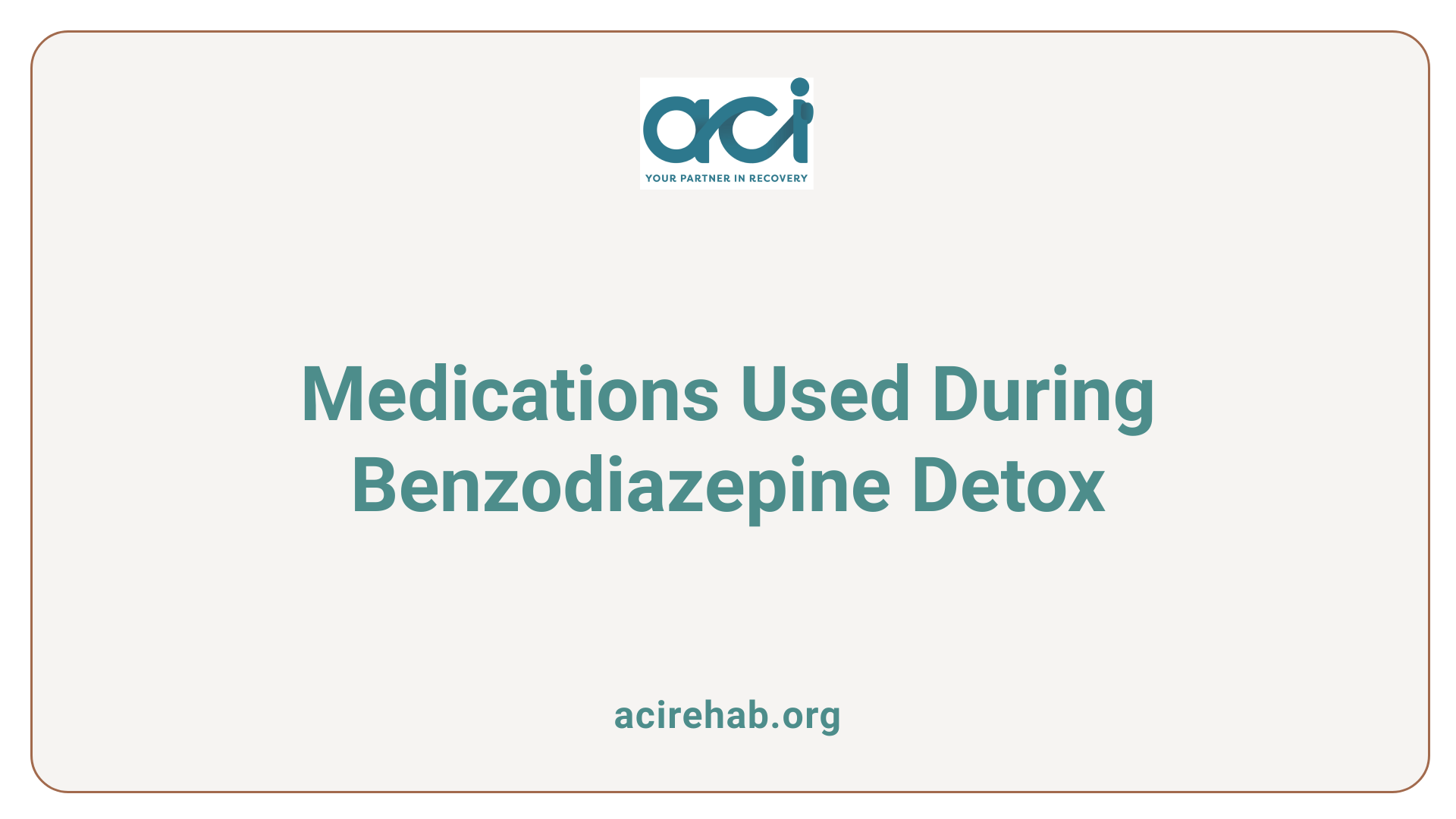
What medications are used during benzodiazepine detox?
During the process of benzodiazepine detox, specific medications play a crucial role. Commonly used tapering medications include Diazepam (Valium) and Clonazepam (Klonopin). These medications are preferred because they have a longer half-life and are generally less potent than other short-acting benzodiazepines like Xanax or Ativan.
Management of withdrawal symptoms
The tapering method is designed to gradually reduce the dosage of benzodiazepines, helping to manage withdrawal symptoms. Common withdrawal symptoms that may require medical intervention include:
- Anxiety
- Insomnia
- Muscle discomfort
- Tremors
Effective management of these symptoms is essential, as abrupt cessation can lead to severe complications such as seizures and hallucinations, especially in individuals with a history of heavy use.
Importance of medical supervision
Medical supervision during detoxification is indispensable. Healthcare professionals can monitor withdrawal symptoms and adjust medications accordingly. This oversight ensures not only the safety of the individual but also helps to reduce the psychological distress associated with withdrawal. Without appropriate medical support, individuals may encounter life-threatening situations or experience heightened symptoms.
In summary, a carefully tailored tapering schedule, combined with professional oversight, significantly mitigates the risks involved in benzodiazepine detox and enhances the likelihood of a successful recovery.
Feasibility of At-Home Detox
Is it safe and feasible to detox from benzodiazepines at home?
Detoxing from benzodiazepines at home is fraught with risks and generally not advised. The potential for severe withdrawal symptoms can be life-threatening. Symptoms such as seizures, hallucinations, and intense anxiety might occur, especially if the drug is abruptly discontinued. Medical supervision is critical during detox to manage these symptoms and prevent serious complications.
Safety concerns
For those attempting to detox without proper oversight, the likelihood of experiencing dangerous conditions, such as delirium tremens or psychosis, significantly increases. Professional medical detox programs offer 24/7 supervision and support, which are crucial for safely navigating the withdrawal process.
Risks of severe symptoms
Withdrawal symptoms can start as early as 8 to 24 hours after cessation, and the severity can escalate based on the duration and amount of benzodiazepines used. Many individuals may also experience prolonged symptoms that can last for months or even years after stopping the medication. This further emphasizes the dangers of unsupervised detox, which can exacerbate the risk of complications.
Professional detox advantages
In contrast, those who enter professional detox programs benefit from a structured tapering process, which gradually reduces benzodiazepine use to minimize withdrawal effects. Studies indicate that individuals who seek professional help during detox have significantly better long-term recovery outcomes compared to those who attempt to do it alone. This highlights the importance of consulting healthcare providers about detox options rather than opting for at-home strategies.
Comparing Detox Options
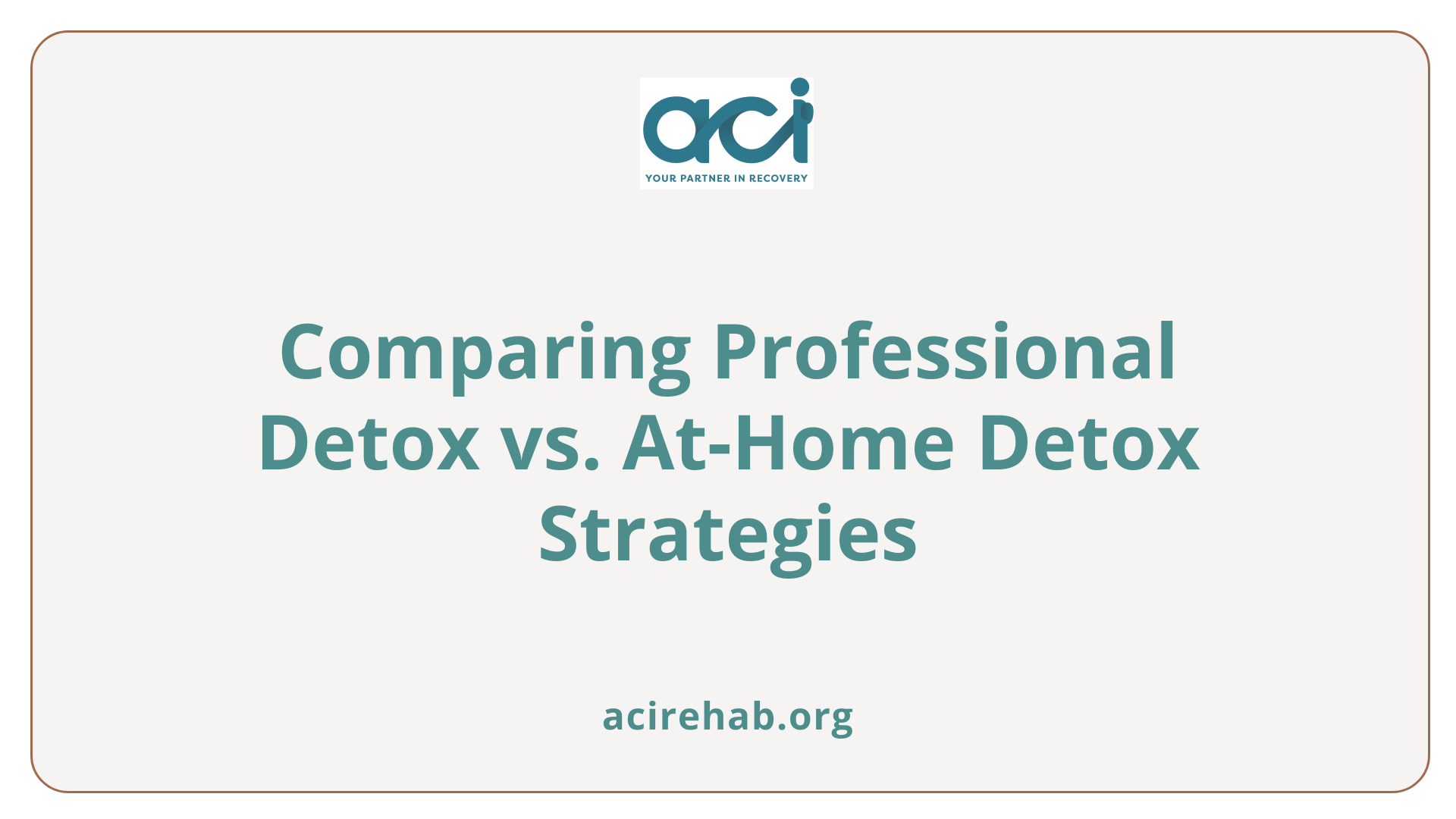
What are the benefits of medically supervised benzodiazepine detox compared to at-home detox?
Medically supervised benzodiazepine detox offers significant advantages over at-home detox, primarily through professional monitoring and intervention. Withdrawal from benzodiazepines can lead to severe symptoms, including seizures and hallucinations, particularly in individuals with a history of heavy use.
A medical team can implement a tapering process, gradually reducing the drug dosage to minimize the risk of dangerous withdrawal effects. This method, while still allowing symptom management, significantly decreases the likelihood of severe complications.
In addition to physical care, professionals can provide immediate assistance for common withdrawal symptoms such as anxiety, insomnia, and physical discomfort. Continuous support and regular check-ins enhance the psychological well-being of individuals going through this challenging process, creating a more supportive detox environment.
What are the risks of home detox?
Home detox from benzodiazepines carries considerable risks, making it an unwise choice for most individuals. The potential for severe withdrawal symptoms, including severe anxiety, tremors, and seizures, can lead to a medical emergency that is far more difficult to manage outside of a clinical setting.
Attempting to detox at home may also increase the chance of relapse. Those engaging in self-detox often find themselves in a vulnerable state, which can trigger cravings, leading to a dangerous cycle of withdrawal and substance use.
What are the success rates?
Studies indicate that individuals undergoing professionally supervised detox programs tend to have higher success rates compared to those trying to detox at home. For instance, participants in medical detox programs benefit from tailored tapering strategies and 24/7 monitoring, enhancing their chances of successful recovery.
In contrast, home detox efforts are often marred by the intensity and unpredictability of withdrawal symptoms, leading not only to lower success rates but also to the potential for serious health complications. Here’s a breakdown of the two options:
| Aspect | Medical Detox | Home Detox |
|---|---|---|
| Supervision | Continuous medical monitoring | No professional support |
| Withdrawal Management | Tapering schedule to minimize effects | Risk of severe symptoms |
| Psychological Support | Professional counseling available | Limited or no support |
| Success Rates | Higher, with professional interventions | Lower, increased relapse risk |
In conclusion, medically supervised detox is crucial to ensuring a safer, more effective approach to overcoming benzodiazepine dependence.
Effective Coping Strategies During Detox
What coping strategies can help during benzodiazepine detoxification?
Coping with benzodiazepine detoxification can be a challenging journey, but several strategies can effectively assist individuals during this crucial time. Engaging in therapy is a significant first step. Cognitive Behavioral Therapy (CBT) helps address underlying psychological issues related to addiction, providing tools to manage cravings and anxiety. Another effective approach is Motivational Interviewing (MI), which inspires personal motivation for change.
Support groups can also play a vital role in recovery. Sharing experiences with others facing similar challenges fosters community and reassurance, creating a sense of belonging. This support network can help reduce feelings of isolation and increase accountability.
How do lifestyle changes contribute to detoxing?
Implementing healthy lifestyle changes can improve overall well-being during detox. Regular exercise has been shown to alleviate stress and anxiety while promoting better mood stability. A balanced diet rich in vitamins and minerals can enhance physical health, contributing to improved resilience during withdrawal.
Additionally, maintaining good sleep hygiene is crucial. Establishing a regular sleep schedule, minimizing screen time before bed, and creating a calming bedtime routine can significantly enhance sleep quality, which might be disrupted due to withdrawal symptoms.
Why is supervised tapering important?
Perhaps the most critical aspect of detoxing from benzodiazepines is following a medically supervised tapering plan. Gradual dose reduction minimizes the intensity of withdrawal symptoms, leading to a safer and more comfortable experience. Under professional guidance, tapering ensures close monitoring of symptoms and necessary adjustments to treatment as needed, significantly reducing the risk of complications or severe withdrawal symptoms.
Finally, considering aftercare support is essential to prevent relapse, providing continued assistance and resources for those transitioning away from benzodiazepine use.
Dangers of Self-Detoxing
Withdrawal Syndrome
Detoxing from benzodiazepines at home can lead to a severe withdrawal syndrome. Symptoms can start as soon as 8 to 24 hours after the last dose. Common symptoms include anxiety, panic attacks, insomnia, and tremors. In more severe cases, individuals may experience hallucinations and seizures, which can be life-threatening.
Potential for Complications
Attempting an at-home detox can result in serious health complications. Without medical supervision, managing severe symptoms such as delirium tremens and severe anxiety becomes extremely difficult. Professional detox facilities provide continuous monitoring and interventions that can be critical for safety.
Relapse Risks
Self-detoxing poses a significant risk for relapse. The discomfort of withdrawal symptoms can lead individuals to resume using benzodiazepines or other substances to alleviate their suffering. This pattern can cause the kindling phenomenon, where repeated withdrawal attempts lead to worse symptoms each time, making recovery even harder.
| Dangers of Self-Detoxing | Withdrawal Syndrome | Potential Complications | Relapse Risks |
|—————————–|————————-|—————————-|—————————–|
| Severe anxiety | Starts within 8-24 hours | Life-threatening symptoms | Increased likelihood of relapse |
| Panic attacks | Includes seizures | Difficulty managing withdrawal | Worsening symptoms over time |
| Insomnia | Hallucinations | Extreme health risks |
| Tremors | Delirium | Lack of medical support |
| Adverse health effects | Long duration of symptoms | Need for professional care |
| | | |
Overall, the dangers associated with self-detoxing from benzodiazepines underscore the necessity of seeking professional medical support.
Educational Resources for Detox
Where can I find educational resources on the implications of benzodiazepine detox?
You can find educational resources on the implications of benzodiazepine detox through several channels. Addiction treatment centers, mental health organizations, and various online platforms dedicated to substance use education offer a wealth of information. These resources typically include guides detailing the withdrawal process, common symptoms, and the critical importance of medically supervised detox.
Understanding that withdrawal symptoms can vary based on the type and duration of benzodiazepine use is vital. A tapering schedule supervised by healthcare professionals is often recommended to ease this process. Additionally, resources may cover managing post-acute withdrawal syndrome (PAWS), which can extend months after discontinuation of the drug.
Also, consider reaching out to local support groups or participating in online forums to gain firsthand experiences and gather additional insights. These platforms can supplement the information you obtain from professional resources and empower you throughout the detox journey.
The Long-Term Recovery Journey
Post-Acute Withdrawal Syndrome
Post-acute withdrawal syndrome (PAWS) can affect individuals for months, or even years, after they stop using benzodiazepines. Symptoms may include anxiety, insomnia, and mood fluctuations, which can make the recovery process challenging.
Continuing Support and Therapy
Engagement in ongoing therapy, such as cognitive-behavioral therapy or support groups, provides essential tools for coping with PAWS. These approaches encourage healthy coping strategies, emotional regulation, and reduce the risk of relapse.
Importance of Professional Care
Professional support is crucial not just during detox but throughout the recovery journey. Regular check-ins with healthcare providers can help manage symptoms and support a long-lasting recovery. Medications may also be prescribed to assist with lingering withdrawal effects.
| Topic | Description | Importance |
|---|---|---|
| Post-Acute Withdrawal Syndrome | Ongoing symptoms post-detox | Understanding long-term recovery dynamics |
| Continuing Support and Therapy | Engagement in therapy and support groups | Coping and relapse prevention strategies |
| Importance of Professional Care | Regular medical oversight during recovery | Ensures safety and effective management |
Concluding Thoughts on Benzodiazepine Detoxification
Detoxing from benzodiazepines is a complex process that carries significant risks, making professional medical supervision a critical factor for success. While the allure of at-home detoxification might tempt those looking for a quick solution, the potential for severe withdrawal symptoms and complications underscores the need for a medically supervised approach. By engaging in professional detox programs and utilizing effective coping strategies, individuals can navigate the challenging withdrawal journey and lay the groundwork for long-term recovery. Investing in continued care and support ensures safety and increases the likelihood of maintaining sobriety.
References
- Benzo Withdrawal Symptoms, Timeline & Detox Treatment
- Dangers of Detoxing at Home for Drugs & Alcohol
- Can I Detox From Benzodiazepines at Home? | Delphi Health Group
- How Long Does It Take to Detox from Benzodiazepines?
- Can You Detox From Benzos At Home? | Steps to Recovery
- Benzodiazepine Detox | Withdrawal & Treatment – Sanctuary Lodge
- Benzodiazepine Withdrawal and Detox – Addiction Center
- Benzodiazepine Detox | Benzo Withdrawal & symptoms | UKAT

